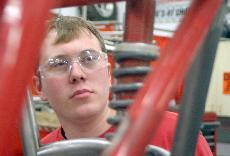
Inside the mechanical and aerospace engineering lab lies a mechanical shop
cluttered with machinery, car frames and engine parts. This is the “home court” of
the motorsports club team, a two-part team responsible for designing, building and
racing automobiles.
According to team member Drew Ulrich, a senior in mechanical engineering, the club
is split into two teams: one responsible for designing a Formula 1-style race car
and one responsible for a baja-style off-road race car.
“The Formula 1 team is on road, around cones on a road course,” Ulrich said. “And
the baja sports is all off-road, like a motocross track.”
Ulrich, a Formula 1 team member, said every year the team develops a new car to
race. He said the time constraints of preparing a race car are incredibly demanding.
“We start usually in August designing the next car,” Ulrich said. “We try to
finalize the design close to the beginning of the year, and then move on to the
construction and try to finish that up in March.”
Ulrich said the Formula 1 competition is set for May 16, and in order to have the
car built and tested by drivers, there will likely be a few late nights between now
and then.
“We have to make it happen in a year basically,” Ulrich said. “We’re always pushing
to get things done as quickly as possible. We have it set in our minds to get
everything done by certain deadlines. The competition date is set, so we try to get
it done in time to test.”
According to Ian Sheeley, a junior in mechanical engineering, the goal of the club
is to blend engineering and mechanical knowledge while working together as a group.
“It’s a combination of engineering prowess and creativity,” Sheeley said. “While at the
same time [you’re] working within a group to accomplish a common goal. You can’t
point to any one thing on the car and say ‘That’s what makes it fast.’ It’s the mix
of machine and everyone’s time.”
The process and resources involved with funding a high-powered race engine and frame
is costly. According to Ulrich, the team receives funds from various sources.
“The University helps us,” Ulrich said. “The college of engineering usually makes
some contributions and gives us some cash to buy things with. And then we go to
friends, family, alumni and local companies to try to get more funding.”
Jason Short, a senior in mechanical engineering and a four year Formula 1 team
member, said the team also has sponsors who help greatly without giving money.
“A lot of times we get work donated,” Short said. “For example, we get free Goodyear
tires. We get a lot of machining time donated, for when we need to make stuff we
can’t make in the shop. It’s a lot of nonmonetary donations.”
Short also said even though the club receives help, it can only do so much with
the money it has.
“We try to make things the best we can in the amount of time we have with the budget
we have,” Short said. “A lot of times some of the ideas we come up with aren’t
possible to actually make happen. Typically with the resources we have, we can only
make so much progress because there is so much development in a year.”
Regardless of resources, the Formula 1 team continues to work diligently on a
nightly basis. Short said at least one of the 15 team members is working in the shop
every day. And though mechanical engineers occupy the majority of club members,
Short added the club is always looking to grow in numbers and support.
“We’re open to all majors,” Short said. “And we’d love to have some business folks
and finance folks help out with the donations and the money management side. We’re
truly a self-running race team.”